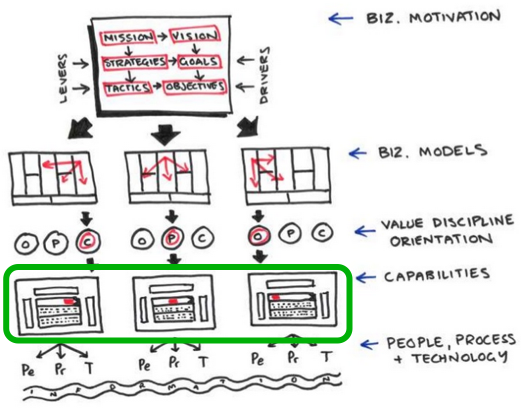Positioning Enterprise Canvas in enterprise-architecture work
As I mentioned again quite recently, I’m always pleased to see how others use my work, because there are usually themes in there that I hadn’t seen before. So the other day, whilst listening in on the Open Group webinar by Hugh Evans of Enterprise Architects, on ‘Sketching a roadmap for enterprise-architecture in the age of digital disruption‘, I was quite excited to see what looked like a really useful positioning for Enterprise Canvas:
This is from slides 25 and 26 on the slidedeck for the webinar; much the same images occur again on slides 40, 67 and 69-71. (The ‘O’ ‘P’ ‘C’ next to ‘Value Orientation’ stand for ‘Operational-excellence’, ‘Product-leadership’ and ‘Customer-intimacy’ respectively, by the way.) Here’s another copy with a green highlight around the bit that interested me:
And, for comparison, here’s a view of the core Enterprise Canvas, minus its usual ‘investor/beneficiary’ section below the main service-entity:
In other words, looks pretty much the same as those entities highlighted in the sketch – a bit more detail in the Enterprise Canvas diagram, that’s all.
Now it’s important to note that they may not be the same, of course. It’s true that I’ve talked with Hugh and Craig and various others of the Enterprise Architects crew quite a few times over the years; but it’s entirely possible that what’s depicted in the slidedeck is something quite different from Enterprise Canvas, that they’ve developed entirely on their own, and for a different purpose. I don’t know, and it really doesn’t matter. What does matter is that that useful parallel is there, and that their diagram therefore suggests a really good way to describe one type of role of Enterprise Canvas in development and implementation of an enterprise-architecture.
[In principle, we could actually use the overall Enterprise Canvas framework for every role in that diagram, from top to bottom: the core Canvas service-entity and its various adaptations are capable of covering the whole space, from the section at the top marked ‘Biz Motivation’, through ‘Biz Models’, ‘Value Discipline Orientation’, and ‘Capabilities’, right down to ‘People, Process + Technology’ and the underlying ‘Information’ layer, all of it based on a single, consistent, recursive ‘everything-as-a-service’ motif. To keep things simple, though, I’ll assume that we would only use Enterprise Canvas for the ‘Capabilities’ segment of that diagram, as below.]
So let’s split up the whole modelling-implementation in the following way:
- Biz. Motivation: use Nick Malik‘s Enterprise Business Motivation Model (EBMM)
- Biz. Models: use Alex Osterwalder’s Business Model Canvas (BMC)
- Value Discipline Orientation: use the three orientations (‘Operational-excellence’, ‘Product-leadership’ and ‘Customer-intimacy’) to select an emphasis and orientation in a respective service to be modelled in Enterprise Canvas – typically:
- ‘Operational-excellence’: emphasis on combination of supplier-facing (left-side) and self (centre) in Enterprise Canvas
- ‘Product-leadership’: emphasis on self (centre) in Enterprise Canvas
- ‘Customer-intimacy’: emphasis on customer-facing (‘right-side) in Enterprise Canvas
- Capabilities: model as services in Enterprise Canvas, perhaps using a translation via Archimate, such as described in the post ‘From business-model to enterprise-architecture‘, or more briefly in the post ‘Business Model Canvas to Archimate (the short version)‘
- People, Process + Technology: translate downward from Enterprise Canvas into UML, BPMN or other notations, as required
That’s it: nice and simple. 🙂
Comments, anyone?



Tom,
I use a slightly different dependency matrix – http://improving-bpm-systems.blogspot.ch/2013/02/linking-business-strategy-and-it.html – maybe it complements (maybe partially) yours.
Thanks,
AS
Nice, and to refer back I have use
EPIC SCAN for the past (orange)
WISE SCAN for the future (red) and
PACE SCAN for the present (blue)
based on my GLUE thinking. 🙂 So there is interlinks between all the thinking in the Enterprise Architecture thinking which brings us in total forward. Just perfect that way.
What I would not do though is be religious on the applyance of concepts. I usually try every interesting approach I see with repsect to relevance in various areas by trying to see with the eyes of a three year old (e.g. can you imagine a paper clip having the size of the moon?).
So no hierarchy, no strictness, no one way, but just use whatever is out there for whatever you want. Not very scientific though. 🙂
@Kai: “What I would not do though is be religious on the applyance of concepts. … So no hierarchy, no strictness, no one way, but just use whatever is out there for whatever you want. Not very scientific though. 🙂 ”
Very strong agree on all of that (including (or especially?) “to see with the eyes of a three year old”! 🙂 )
There’s a useful and important distinction here, though, between ‘hierarchy’ and ‘discipline’: rigid hierarchies don’t help, but some form of discipline is essential. The discipline can look a bit strange at times, of course – such as in the learning-disciplines of that three-year-old child! 🙂 More on that in my previous post on ‘The science of enterprise-architecture‘.
Hi Tom,
Great post here even though it’s been a long time. But, the concept is still relevant. In your post, you have outlined few tools that you use for mapping out the enterprise architecture. I was using this new tool called StrategicQuadrant at https://www.strategicquadrant.com which allows you to map out your value stream capabilities. It worked out pretty good. It allows you to work in a team setting and assign capability owner. More importantly, it’s free. Thought you might find it helpful.